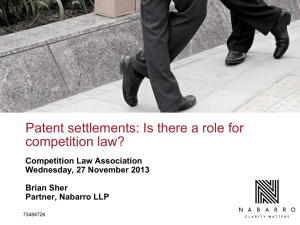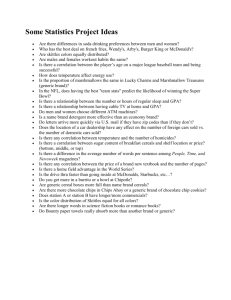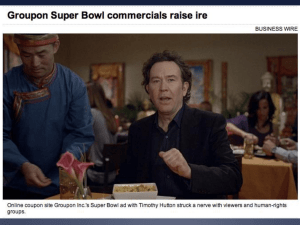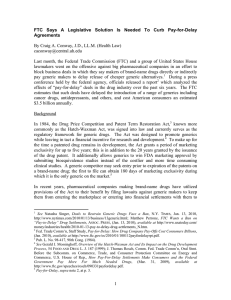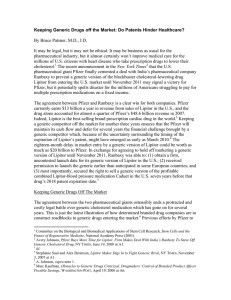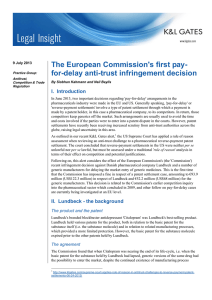Pharmaceutical “Reverse Payments” Markus H. Meier
advertisement
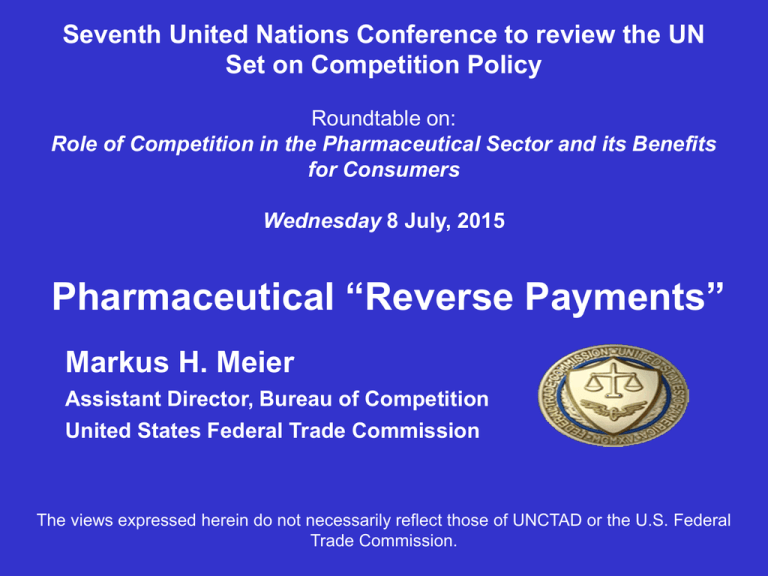
Seventh United Nations Conference to review the UN Set on Competition Policy Roundtable on: Role of Competition in the Pharmaceutical Sector and its Benefits for Consumers Wednesday 8 July, 2015 Pharmaceutical “Reverse Payments” Markus H. Meier Assistant Director, Bureau of Competition United States Federal Trade Commission The views expressed herein do not necessarily reflect those of UNCTAD or the U.S. Federal Trade Commission. Session Overview 1. Provide background on the U.S. regulatory context and the nature of generic drugs. 2. Explain what the FTC means by a “reversepayment” agreement. 3. Examine what’s at stake for consumers. 4. Discuss the current state of the U.S. law. 5. Highlight a recent legal development. Regulatory Context: Hatch-Waxman Act (1984) 1. Maintaining incentives to develop new drugs. – E.g., patent term extensions, 5-year exclusivity for new chemical entities, 30-month stays 2. Increasing availability of lower-priced generic drugs. – Abbreviated process for FDA approval – Special procedures to facilitate patent challenges Nature of Generic Drugs • U.S. Food and Drug Administration evaluates whether generic is “therapeutically equivalent” to brand. 1. Bioequivalent – comparable rate and extent of absorption of active ingredient in the body. 2. Pharmaceutically equivalent – same active ingredient, dosage form, route of administration, strength or concentration. • Under state laws, pharmacists may substitute prescriptions for a brand to a therapeutically equivalent generic. Effects of Generic Entry: Cardizem Example New Prescriptions 300 250 200 CARDIZEM CD Aventis 150 Generic Cardizem Total 100 50 0 1 2 3 4 5 6 7 8 9 10 11 12 13 14 15 16 17 18 19 20 21 22 23 24 25 Months Since Generic Entry Savings from Generic Drugs “Thanks to the 1984 Hatch-Waxman Act, generic pharmaceuticals constitute the quintessential American success story. An independent analysis released in September 2011, shows that the use of generic prescription drugs in the U.S. has saved consumers and the health care system $931 billion over the last 10 years, $158 billion in 2010 alone. That’s an astounding $3 billion in savings every week.” Reverse-Payment Agreements Brand and generic pharmaceutical companies in patent litigation enter an agreement whereby: 1. Generic agrees to refrain from going to market until a certain date. 2. Brand agrees to compensate the generic. – Possibly including: cash; IP licenses; copromotion, co-development, manufacturing, API supply, or “no AG” agreements. Incentives to Enter Reverse Payment Before Generic Entry Brand’s Profits Competition Brand’s Profits Generic’s Profits Consumer Savings Reverse Payment Payment to Generic Brand’s Profits FTC Study (2010) • FTC staff conducted a study of the cost of reversepayment agreements to U.S. consumers and purchasers. • Study found that agreements with compensation restrict generic entry an average of 17 months longer than agreements without. • Study estimated that reverse-payment agreements cost U.S. consumers and purchasers $3.5 billion a year. Overview of Final Settlements (2004-2013) Fiscal Year 2004 2005 2006 2007 2008 2009 2010 2011 2012 2013 Final Settlements 14 11 28 33 66 68 113 156 140 145 Potential Pay-for-Delay 0 3 14 14 16 19 31 28 40 29 0% 27% 50% 42% 24% 28% 27% 18% 29% 20% 8 5 11 16 29 32 49 54 43 41 0 2 9 11 13 15 26 18 23 13 0% 40% 82% 69% 45% 47% 53% 33% 53% 32% 13 11 20 28 26 33 45 46 53 46 0 5 7 12 10 14 19 20 28 13 0% 45% 35% 43% 38% 42% 42% 43% 53% 28% Final Settlements Involving First Filers Potential Pay-for-Delay Involving First Filers Drugs Subject to Final Settlements Drugs Subject to Potential Pay-for-Delay FTC v. Actavis (2013) • Supreme Court rejects the “scope-of-the-patent” test adopted by three U.S. courts of appeal. • Reverse-payment agreements must be analyzed under the antitrust “rule of reason.” (p. 2237) – Reverse payments have the potential for “genuine adverse effects on competition.” (p. 2234) • “[P]atent and antitrust policies are both relevant in determining the ‘scope of the patent monopoly’ . . . that is conferred by a patent.” (p. 2231) FTC v. Cephalon •Trial scheduled to start on June 1, 2015, but FTC announced case settlement on May 28, 2015. • Judge approved the settlement and entered court order on June 17, 2015. • Settlement includes Cephalon’s (and its parent Teva’s) agreement to pay $1.2 billion dollars into a settlement fund. • Fund will be used to pay drug purchasers who overpaid for Provigil. The Challenge: Balancing Patent & Competition Law • Patent gives the right to exclude others from making, using, offering for sale, or selling an invention, through litigation, the threat of litigation, or a refusal to license. • The “scope of the patent” does not include using monopoly profits to pay off potential competitors. • Where an agreement among competitors is secured by sharing monopoly profits, rather than the strength of the patent, patent rights do not trump competition law. www.ftc.gov

